Related Research Articles

James Knox Polk was the 11th president of the United States, serving from 1845 to 1849. A protégé of Andrew Jackson and a member of the Democratic Party, he was an advocate of Jacksonian democracy and extending the territory of the United States. Polk led the U.S. into the Mexican–American War, and after winning the war he annexed the Republic of Texas, the Oregon Territory, and the Mexican Cession.

The Republic of Texas, or simply Texas, was a breakaway state in North America. It existed for close to 10 years, from March 2, 1836 to February 19, 1846. Texas shared borders with Mexico, the Republic of the Rio Grande, and the United States of America. The Republic of Texas had engaged in some complex relations with various nations. The United States was one of the key players that recognized Texas's independence. However, they hesitated to annex the Republic due to domestic affairs with Mexico. European powers had extended their recognition and wanted to engage in trade with Texas. These relations were very significant and shaped Texas's republic. This had led to the annexation by the U.S. which led to the Mexican-American War.

Presidential elections were held in the United States from November 1 to December 4, 1844. Democratic nominee James K. Polk narrowly defeated Whig Henry Clay in a close contest turning on the controversial issues of slavery and the annexation of the Republic of Texas. This is the only election in which both major party nominees served as Speaker of the House at one point, and the first in which neither candidate held elective office at the time.

The Compromise of 1850 was a package of five separate bills passed by the United States Congress in September 1850 that temporarily defused tensions between slave and free states in the years leading up to the American Civil War. Designed by Whig senator Henry Clay and Democratic senator Stephen A. Douglas, with the support of President Millard Fillmore, the compromise centered on how to handle slavery in recently acquired territories from the Mexican–American War (1846–48).
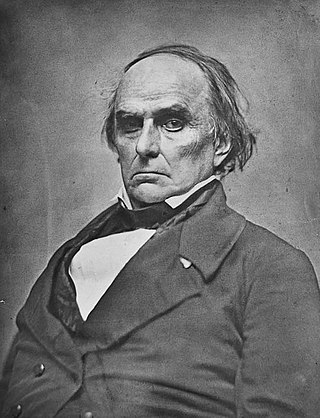
Daniel Webster was an American lawyer and statesman who represented New Hampshire and Massachusetts in the U.S. Congress and served as the 14th and 19th U.S. secretary of state under presidents William Henry Harrison, John Tyler, and Millard Fillmore. Webster was one of the most prominent American lawyers of the 19th century, arguing over 200 cases before the United States Supreme Court in his career. During his life, Webster had been a member of the Federalist Party, the National Republican Party, and the Whig Party. He was among the three members of the Great Triumvirate along with Henry Clay and John C. Calhoun.
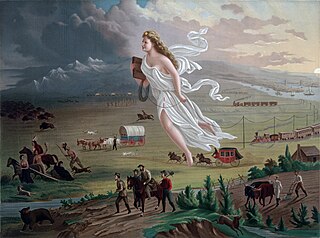
"Manifest destiny" is a phrase that represents the belief in the 19th-century United States that American settlers were destined to expand westward across North America, and that this belief was both obvious ("manifest") and certain ("destiny"). The belief is rooted in American exceptionalism and Romantic nationalism, implying the inevitable spread of the republican form of governance. It is one of the earliest expressions of American imperialism in the United States of America.

The Treaty of Guadalupe Hidalgo officially ended the Mexican–American War (1846–1848). It was signed on 2 February 1848 in the town of Guadalupe Hidalgo.
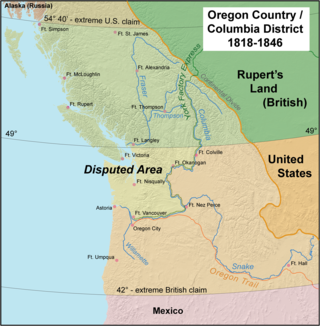
The Oregon Treaty was a treaty between the United Kingdom and the United States that was signed on June 15, 1846, in Washington, D.C. The treaty brought an end to the Oregon boundary dispute by settling competing American and British claims to the Oregon Country; the area had been jointly occupied by both Britain and the U.S. since the Treaty of 1818.

The Republic of Texas was annexed into the United States and admitted to the Union as the 28th state on December 29, 1845.

The Mexican Cession is the region in the modern-day Western United States that Mexico previously controlled, then ceded to the United States in the Treaty of Guadalupe Hidalgo in 1848 after the Mexican–American War. This region had not been part of the areas east of the Rio Grande that had been claimed by the Republic of Texas, which had been claiming independence since its Texas Revolution of 1836 and subsequent brief war for independence, followed afterwards a decade later by the American annexation and admitted statehood in 1845. It had not specified the southern and western boundary of the new state of Texas with New Mexico consisting of roughly 529,000 square miles (1,370,000 km2), not including any Texas lands, the Mexican Cession was the third-largest acquisition of territory in U.S. history, surpassed only by the 827,000-square-mile (2,140,000 km2) Louisiana Purchase of 1803 and the later 586,000-square-mile (1,520,000 km2) Alaska Purchase from Russia in 1867.

The Oregon boundary dispute or the Oregon Question was a 19th-century territorial dispute over the political division of the Pacific Northwest of North America between several nations that had competing territorial and commercial aspirations in the region.
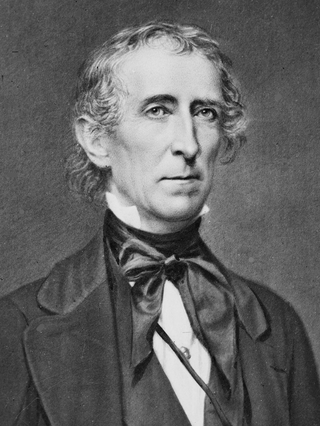
The presidency of John Tyler began on April 4, 1841, when John Tyler became the 10th President of the United States upon the death of President William Henry Harrison, and ended on March 4, 1845. He had been Vice President of the United States for only 31 days when he assumed the presidency. Tyler was the first to succeed to the office without being elected to it. To forestall constitutional uncertainty, Tyler took the presidential oath of office on April 6, assumed full presidential powers, and served out the balance of Harrison's four-year term, a precedent that would govern future extraordinary successions and eventually become codified in the Twenty-fifth Amendment. He was succeeded by James Polk of the Democratic Party.
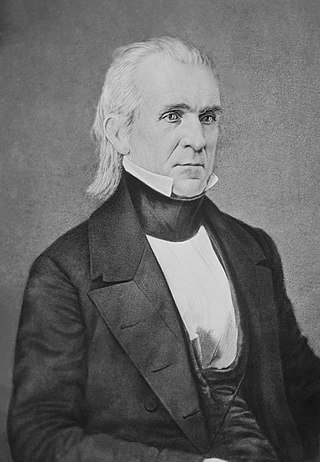
The presidency of James K. Polk began on March 4, 1845, when James K. Polk was inaugurated as the 11th President of the United States, and ended on March 4, 1849. He was a Democrat, and assumed office after defeating Whig Henry Clay in the 1844 presidential election. Polk left office after one term, fulfilling a campaign pledge he made in 1844, and he was succeeded by Whig Zachary Taylor. A close ally of Andrew Jackson, Polk's presidency reflected his adherence to the ideals of Jacksonian democracy and manifest destiny.

John Tyler was the tenth president of the United States, serving from 1841 to 1845, after briefly holding office as the tenth vice president in 1841. He was elected vice president on the 1840 Whig ticket with President William Henry Harrison, succeeding to the presidency following Harrison's death 31 days after assuming office. Tyler was a stalwart supporter and advocate of states' rights, including regarding slavery, and he adopted nationalistic policies as president only when they did not infringe on the states' powers. His unexpected rise to the presidency posed a threat to the presidential ambitions of Henry Clay and other Whig politicians and left Tyler estranged from both of the nation's major political parties at the time.

Republic of Texas–United States relations refers to the historical foreign relations between the now-defunct Republic of Texas and the United States of America. Relations started in 1836 after the Texas Revolution and ended in 1845 upon the annexation of Texas by the United States.

The Republic of Texas was a North American nation from 1836 to 1846; in its short time it established diplomatic relations worldwide, mainly through the cotton trade.

The history of U.S. foreign policy from 1861 to 1897 concerns the foreign policy of the United States during the presidential administrations of Abraham Lincoln, Andrew Johnson, Ulysses S. Grant, Rutherford B. Hayes, James A. Garfield, Chester A. Arthur, Grover Cleveland, and Benjamin Harrison. The period began with the outbreak of the American Civil War 1861 and ended with the 1897 inauguration of William McKinley, whose administration commenced a new period of U.S. foreign policy.

The history of U.S. foreign policy from 1829 to 1861 concerns the foreign policy of the United States during the presidential administrations of Andrew Jackson, Martin Van Buren, William Henry Harrison, John Tyler, James K. Polk, Zachary Taylor, Millard Fillmore, Franklin Pierce, and James Buchanan. During this era, the United States annexed the Republic of Texas, acquired the Mexican Cession by defeating Mexico in the Mexican–American War and partitioned Oregon Country with the United Kingdom of Great Britain and Ireland. The period began with the inauguration of Jackson in 1829, while the onset of the American Civil War in 1861 marked the start of the next period in U.S. foreign policy.
The 1844 State of the Union address was delivered by the 10th President of the United States John Tyler on December 3, 1844, to the 28th United States Congress.
The 1845 State of the Union Address was presented by President James K. Polk to the 29th United States Congress on December 2, 1845.
References
- ↑ "Joint Meetings, Joint Sessions, & Inaugurations | US House of Representatives: History, Art & Archives". history.house.gov. Retrieved 31 October 2024.
- 1 2 3 "John Tyler - State of the Union Address -- 1843". The American Presidency Project. Retrieved 19 October 2024.